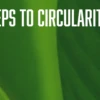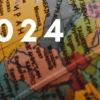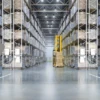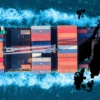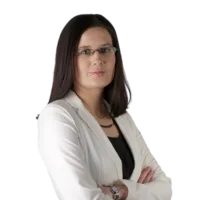The logistics sector does not have to be part of the climate problem. However, Bleckmann experiences it can be part of the solution through Corporate Social Responsibility measures and policies. The logistics specialist takes various actions to reduce its own and its customers' ecological footprint. How does Bleckmann reduce its impact on the environment.
"We have always been a part of the problem. Now we want to be part of the solution.", says sustainability manager Ron Thijssen. Since October 2019, Ron has been Manager Corporate Social Responsibility (CSR) at Bleckmann. From this position, he uses his 30 years of experience to make the logistics market leader in supply chain management for fashion and lifestyle brands thoroughly greener.
The sustainability approach has become more central at Bleckmann. A few years ago, a customer asked why the coffee was drunk from plastic cups. Bleckmann immediately bought paper cups. This small change created a mental click in the company; small ideas were collected and implemented. From that moment onwards, bigger plans grew.
"From the beginning, we kept in mind that the key is not only achieving big goals. Implementing concrete steps in smaller projects is just as important," Ron says.
"Sustainability is a journey, not a destination."
- Ron Thijssen, Manager Corporate Social Responsibility at Bleckmann
The logistics sector takes up the CSR challenge
The challenges on this journey are significant. In 2020, global international logistics emitted 7.3 Metric tonnes of CO2. Today, medium and heavy trucks account for 22 per cent of total CO2 emissions from transport. Aircraft is responsible for 8 per cent, shipping for 11 per cent.
Studies predict the ecological impact of e-commerce will rise even further between 2019 and 2030: from 19 to 25 million tonnes of CO2, from 5.3 vehicles involved to 7.2 million.
Logistic companies are taking steps to stabilise or reduce their impact. Corporate Social Responsibility ranks eighth in the list of the ten biggest challenges faced by logistics service providers worldwide. The fifth challenge, 'Compliance & Regulations', is also related to sustainability. Legislation is explicitly pushing fashion & lifestyle brands - and thus their logistics service providers - towards more sustainability.

The wishes of the consumers make it extra challenging. On the one hand, they ask for more sustainability, speak out against child labour and low-wage jobs and prefer organic cotton. But on the other hand, 45 per cent of them want parcels to be delivered to their front door as fast as possible (and 16 per cent in their letterbox), preferably for free or at least cheap and fast. More than 50 per cent of the consumers receive their ordered products in less than a week. Six per cent of the orders are even delivered the same or the next day.[1]
Sustainably meeting these needs is a big challenge.
Studies anticipate that the biggest CO2 savings can be made in packaging (packaging-level emissions, 45%), returns (return rates, 25%) and buildings (property-level emissions, 15%)
Bleckmann is involved in all these domains. This blog gives a selection of its our achievements and plans on five levels:
Level 1. Start with small, achievable actions
Level 2. Setting clear, larger goals
Level 3. Measuring ecological footprint more accurately
Level 4. Offering green solutions to customers
Level 5. The largest circular distribution centre in the Netherlands
Level 1. Start with small, achievable actions
The change from plastic coffee cups to paper opened Bleckmann's eyes to the fact that small and feasible actions can reduce its environmental impact. This small action generated enthusiasm among employees and customers, increasing support for more profound sustainable decisions.
Some examples of such decisions are separating waste, reducing energy consumption by replacing fluorescent lighting with LED, bee meadows and planting trees in open spaces around the distribution centres.
More sweeping actions were also launched:

Bleckmann became a member of Lean & Green a European network with logistics service providers and transport companies working together to reduce their carbon footprint. Their ambition is to comply with the Paris climate agreement, i.e. no CO2 emissions by 2050. They aim to do this through alternative fuels, renewable energy, multimodality, less packaging, sustainable use of materials, circular economy, etc. Each member can earn stars. The greater the emission reduction members achieve, the more stars they can put next to their company's name. Bleckmann earned its first star.
So far, Bleckmann has achieved the most significant CO2 savings through solar panels on distribution centres' roofs. This reduced the CO2 emissions of the entire company by 15 to 20 per cent. Bleckmann Netherlands has been running entirely on renewable energy since July 2021. The Belgian region runs at 89 per cent renewable energy. Bleckmann Belgium is collaborating with distribution centre owners to move towards more renewable energy.
The process of plastic recycling was improved. All plastic waste used to go in one container. Today, operational teams separate three types of plastic. After that, they are pressed into bales before going into the container. Thanks to separating plastic, it can be better recycled. And by making plastic waste more compact, transport and its linked costs and CO2 emissions have lowered by a factor of eight.
Bleckmann partnered with a waste specialist to reach a recycling rate of 90 per cent by 2023 in an efficient, cost-effective way. Several pilot projects have been successfully rolled out to the entire company.
Today, the boxes used for packaging consist of 85 per cent recycled material. Used packages are sent to a recycling company to make into new boxes. A recycling rate of 90 per cent was achieved a year before the deadline, which allowed looking at how to do even better.
Level 2. Setting clear, larger goals
These small actions were the stepping stone to a more embedded Corporate Social Responsibility programme. CSR requires more than initiatives that reduce CO2 emissions; it is about more than plastic and the environment. CSR is about people, planet and profit, earlier referred to as the three Ps.
CSR manager Ron Thijssen developed a policy plan that sets measurable goals and clarifies Bleckmann's CSR direction to internal and external stakeholders. "Our CSR tasks must be SMART: Specific, Measurable, Attainable, Relevant, Timed. That helps us to monitor and improve them."
Bleckmann got inspired by globally recognised Sustainable Development Goals, the UN's SDGs. These are "17 goals to transform our world". Beckmann selected five goals on which it has an impact:

Goal 8: decent work and economic growth
Goal 9: industry, innovation and infrastructure
Goal 12: responsible consumption and production
Goal 13: climate action
Goal 17: partnerships for the goals
"You can't become more sustainable and grow sustainably alone," Ron acknowledges. "To make real progress on CSR, we establish partnerships with suppliers, customers and governments at an early stage. This is how we achieve results and will be recognised as a sustainable logistics company."
"To make real progress on CSR, we establish partnerships with suppliers, customers, and governments at an early stage." - Ron Thijssen, Manager Corporate Social Responsibility at Bleckmann
A part of CSR that often receives less attention is the social one. Bleckmann pays attention to the social aspect of CSR too. People are central to the logistics specialist. Bleckmann wants to be an employer of choice because of its entrepreneurial, positive corporate culture; employees have the freedom to take the initiative, propose solutions and build a career.
Knowing that the logistics sector is affected by modern forms of slavery, Bleckmann sets up actions to counter this problem. Discrimination and exploitation are actively opposed. As a result, every employee receives a fair wage, and everyone gets opportunities, regardless of their background, past, degree or orientation. This social aspect of CSR is widely promoted through lectures in schools, talking to students, bringing companies together and introduction at onboarding.
Level 3. Measuring ecological footprint more accurately
The adagio 'measuring is knowing' also applies to CSR. Without numbers, it is impossible to map out a more sustainable future.
Some logistics players indicate their parcels will be handled and shipped CO2-neutral by 2035. They announce this without any further information, even without collecting data or drafting a policy on this topic.
Bleckmann believes that you can only achieve CSR objectives if you regularly check your score on each one of the objectives. Numbers are indispensable in making progress.
Therefore, Bleckmann wants to map the CO2 emissions of the entire logistics supply chain. Based on that information, measures can be taken, and customers and partners can be thoroughly informed.
The information is collected in three dashboards:
- a dashboard on energy consumption
- a dashboard on waste and recycling
- a dashboard on the carbon footprint of transport
These dashboards map the current situation and monitor the relevant parameters in further detail. Since the end of 2022, the energy dashboard tells how much energy the various distribution centres are consuming. As sudden changes are immediately noticeable, it is possible to steer processes in the right direction. It is also possible to see the immediate impact of measures taken, for example, the impact on energy consumption. This helps Bleckmann to communicate to customers about the energy demand of their part of the distribution process.
Something similar will happen with the dashboards on waste and transport. They collect raw data and make them insightful.
"More and more customers want information on the carbon footprint of their operations," Ron experiences. "These dashboards are going to help us with that. For example, our customers ask: How much waste do you produce for my brand? What is the carbon footprint of my transports? So far, we have depended on information from transporters. But they don't always have figures. Until recently, nobody was worried about the CO2 emissions per parcel. Now everyone is looking for these figures."
"More and more customers want information on the carbon footprint of their operations. Our dashboards provide insight."
- Ron Thijssen, Manager Corporate Social Responsibility at Bleckmann
"The dashboards will provide the answers to customers' questions", Ron knows. "When our customers want to know their carbon footprint in 2020 or 2021, we can tell them exactly, thanks to all the data collected. Data collection is not easy with every partner; there is a huge variety between partners: some provide more information than others. But we keep asking for it repeatedly because we know how important data are in helping us and our clients to achieve climate goals."
An important side note for companies that are less interested in figures about their impact today is that more and more institutions are asking for data that make CSR goals measurable. There are voices within the European Union that want to oblige all listed and unlisted companies to disclose this information from 2025. "That means our customers will soon need this data by law," Ron explains. "The information disclosure we are currently setting up is therefore not some fun gimmick, but an indispensable part of tomorrow's logistics."
Level 4. Offering green solutions to customers
Sharing figures is one aspect. Bleckmann also helps its customers to achieve their climate goals in many other areas.
"We are constantly looking at how we can help our customers with their CSR challenges."
- Ron Thijssen, Manager Corporate Social Responsibility at Bleckmann
"I am proud that Bleckmann is not only making its own organisation more sustainable but also constantly looking at how we can make progress in CSR for other companies", says Ron. "Becoming more sustainable is not only an aim but also a journey. We must continue to engage in these things and keep talking about them with all stakeholders to keep coming up with new green solutions."
"By looking for cooperation with partners in the logistics chain and working towards chain integration, benefits can be achieved in both sustainability and financial terms."[2]
Bleckmann gives its customers the opportunity to make the supply chain more sustainable. An example. Does a brand want no more plastic as a part of its CSR policies? Then that's possible. Or does a brand want to give its customers the opportunity to opt for shipments without plastic in the packaging? For all the materials used in its distribution centres, Bleckmann has a plastic-free alternative.
As large carriers cannot immediately run on hydrogen or electrify everything, Bleckmann is forging partnerships with (mostly new) carriers that are green from origin. The central question is: how can we make the last delivery mile sustainable?
To answer that question and offer each customer a tailor-made solution, we partner with several carriers specialised in green transport solutions, such as fietskoeriers.nl, Paack, Stuart and Budbee.
Thanks to these collaborations and the green investments of our existing transportation partners, our transportation network will continue to grow into a European Green Heroes network, a comprehensive transportation solution with a smaller carbon footprint.
For long-distance delivery, Bleckmann advises customers about the differences between shipping and air transport. In doing so, it points to the environmental benefits of shipping. The geographical locations of Bleckmans distribution centres also provide an environmental benefit. Thanks to their central location in Europe, the miles driven from the ports to the distribution centres and from there to the end customers are reduced.
Returns are a big challenge for a lot of brands. In the blog post 5 tips to have fewer returns, Bleckmann suggests how its customers can reduce the number of returns.
The article on The Renewal Workshop elaborates on circularity solutions for textiles, such as the ecological processing, repair and resale of returned textile products.
Level 5. The largest circular distribution centre in the Netherlands
Bleckmann realises increasingly large projects with significant impact. For example, Bleckmann and VDR Bouwgroep are building the largest demonstrably circular fulfilment centre in the Netherlands. The building will be completed by March 2023 in Almelo, Twente region.
The circular distribution centre under construction shows that logistics building can be sustainable if you join forces and take responsibility. It is more than a statement. With this project, Bleckman takes the next step in sustainability: it aims to inspire the entire logistics sector, the construction sector, the real estate market and governments to join the circular path.
The new circular fulfilment centre has a total floor area of 45,600 sq m and a clear internal height of 15.2 metres. This internal height allows optimal use of the available cubic metres and saves on scarce business land. No one has built circularly on this scale before.
Read more about this unique DC in the press release: Bleckmann and VDR Bouwgroep build the largest circular distribution centre in the Netherlands.

In this article, you learned that Bleckmann started with small steps towards more sustainability. Each step was followed by a bigger step than the one before, the new circular fulfillment centre being the biggest step on the path to sustainability.




